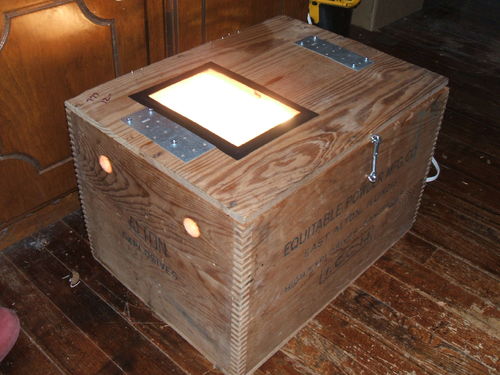


DIY Egg IncubatorĪre you eager to hatch your fresh eggs, here is a cool way you can create an egg incubator at the comfort of your home and hatch as many eggs as you want with ease You need some wood boards cut into their required sizes, some door hinges, and glue? No screws were used except the ones for the hinges. The rice husk will have to fill the carton into all corners then you begin to place your fresh eggs inside. You will need a carton box, a light bulb, and its holder, and lots of rice husk for this project. Here is another guide that is quick and easy, but way simpler than the previous video guide. See also 25 DIY Hummingbird Feeder Plans: Do It Yourself Easily 3. The making process is simple and easy to perform.
#Homemade incubator ideas how to
Here is another amazing video guide on how to quickly make an egg incubator, you’ll need a carton box, a light bulb and its holder, a cup of water, some rice husk, and a few other supplies. With these supplies, you can make the best egg incubator that will suit your needs. DIY Egg Incubator Without Electricityįor this project, you will need a 20 liters water can, rice husk, a small plastic storage box, glue gun, fresh eggs of 2 - 12 days old, a temperature, and humidity meter, a 15W bulb with a plug and its holder, and water.

Still want to have a go at a DIY incubator? Let's look at how it can be done. It's important to remember that in any clutch of eggs there will be some which don't hatch for all kinds of reasons which are nothing whatever to do with the incubator: low fertility levels, time of year, handling and transporting problems, poor storage, bacteria infecting porous eggs and so on.Some studies put it as low as 33%, although others claim to have a much higher success rate. Hatch rates in general from homemade incubators tend to be well under 50%.They tend not to work as well in rooms which have a low or fluctuating temperature - although this is also true of some of the smaller commercial incubators.If they're not controlled properly, hatch levels tend to be very poor. These are two of the most critical parts of incubation. The biggest disadvantage is that it's notoriously difficult to keep temperature and humidity levels right.You have the satisfaction of knowing you're using re-cycled (upcycled) items.You can make it largely from re-cycled items you may have around your home, so it costs even less.

It's a much less expensive way of hatching than using a store-bought incubator - at least on the surface.In this article, I examine the positives and drawbacks of doing it yourself, and provide three sets of instructions to help you make your own if you decide that's the way you want to go.Īnd I talk to our local Farmers' Union about the fish tank incubator they have used successfully for generations. Is it really that simple? Have we become too reliant on commercially-produced gadgets to perform what is essentially a very natural process? Our friend Claudio tells me his mother (in rural Italy) used to hatch chicks in the warm space under the kitchen fireplace if there was no broody hen available. So can a homemade incubator be less expensive while still providing the optimum levels of heat, humidity and security needed for a successful hatch? The information in this article is taken from reading extensively about DIY incubators, talking to members of our local farmers' union about their "fish tank incubator" (see below), and hearing from friends and neighbours who have used them - and still do. But many of my friends here in Italy have - in fact, my Brinsea incubators became something of a celebrity because they are such an unusual sight.


 0 kommentar(er)
0 kommentar(er)
